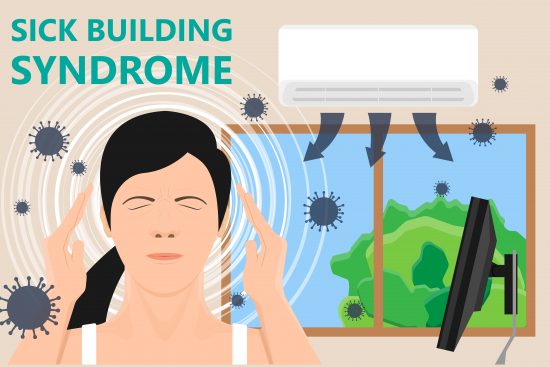

Did you know that indoor air quality problems cost the U.S. economy approximately $168 billion annually, as reported by the National Air Duct Cleaners Association (NADCA)?
And while that tidbit may be concerning in and of itself, it only begs the question — what is the source of such financial strain on the individual property owner on such a regular basis?
The answer is one that is more common than you might realize: Sick Building Syndrome. Here’s what you need to know…
What Is Sick Building Syndrome?
According to an article published by the Health Science Journal, “the term ‘sick building syndrome,’ was first coined in the 1970s and is used to describe a situation in which the occupants of a building experience acute health symptoms or a broad range of labels that cover a variety of symptoms which are triggered when people spend time in a particular building.”
In other words, if poor indoor air quality within a property is causing you, your coworkers, or your family to exhibit negative physical symptoms, you are dealing with a “sick building.”
The most common symptomatic complaints, as reported by the Environmental Protection Agency (EPA), include:
- Headaches
- Irritation of the eyes, nose, and/or throat
- Dizziness
- Nausea
- Dry cough
- Skin irritation
- And more
Another indication that sick building syndrome (SBS) is the culprit of your woes is that symptoms will subside as soon as you exit the property in question.
What Causes Sick Building Syndrome?
Studies indicate that there is no singular cause of SBS, so much as it is a result of poor overall indoor air quality.
Common causes of SBS (which may be singular or combined in nature) may be:
- Poor HVAC maintenance
- The presence of chemical contaminants, such as volatile organic compounds (VOCs)
- Biological contaminants such as mold, fungi, and bacteria
- Reduced rates of ventilation
- And more
Further, the U.S. Occupational Safety and Health Administration (OSHA) has specified that “energy conservation measures instituted during the early 1970’s have minimized the infiltration of outside air and contributed to the buildup of indoor air contaminants.”
Thus, SBS is far more common today than in comparison to decades past.
What Can I Do About Sick Building Syndrome?
If you suspect your property may be suffering from SBS, professional assistance is always at hand.
Specifically, Luce Air Quality — your local indoor environmental experts — can perform a Healthy Building Check-Up to identify the source(s) of impeded air quality, as well as provide you with guidance in terms of what next steps you should take.
If you’re ready to schedule your assessment, or if you have further questions, simply contact Luce Air Quality today by calling 904-803-1014 or emailing info@luceairquality.com!


